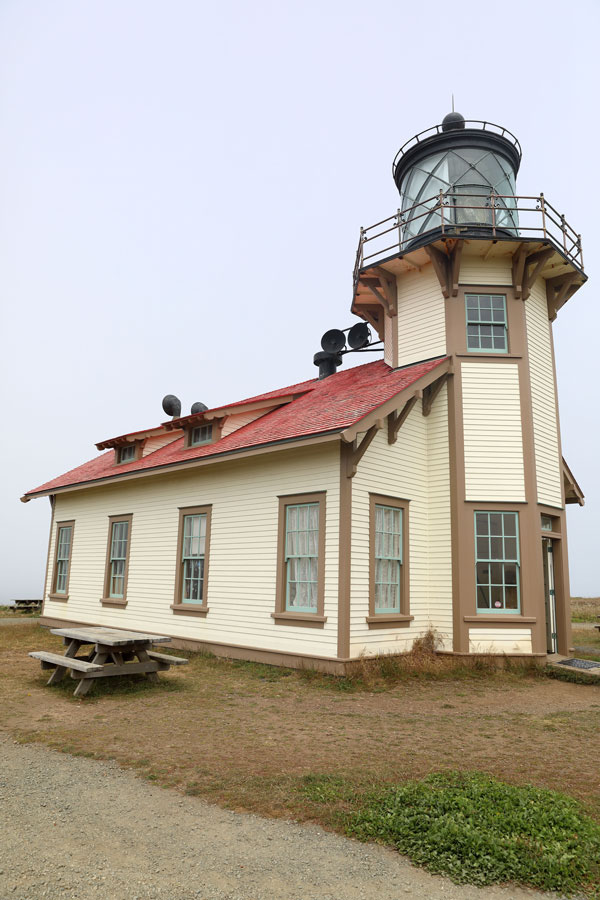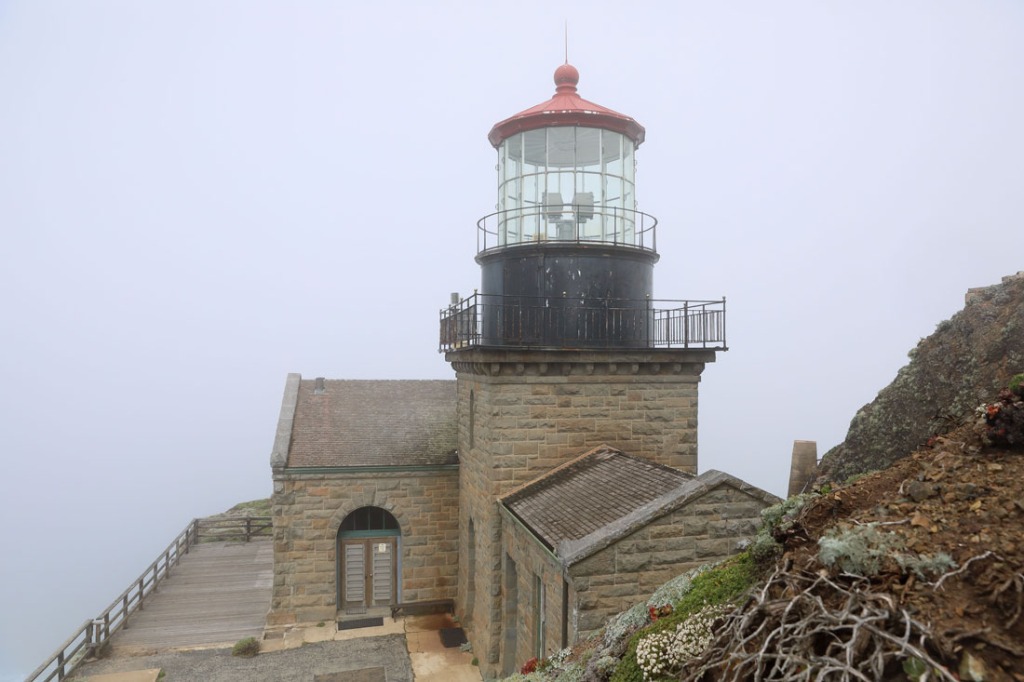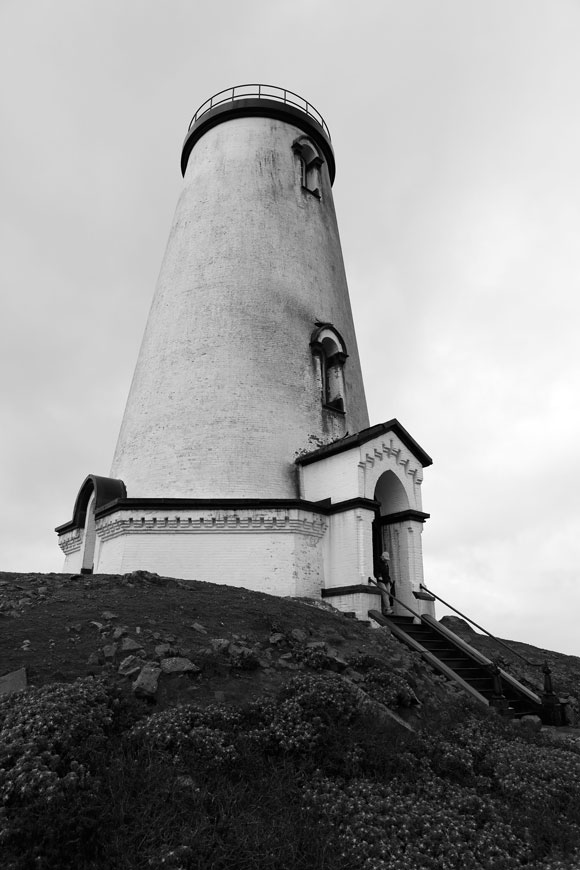We walked the path to the lighthouse in the early morning fog. It wasn’t a thick, soupy fog, but a heavy wispy one that resembles a person’s breath on a cold morning. The faint shapes of low hanging clouds could still be seen as we walked the paved path through a field of tall grass and trees.
It was peaceful, being the only ones on the trail.
Well, there was us and a coyote.
I wasn’t exactly expecting to see any, but I happened to look up and saw something dart across the path. It stopped on the other side, practically hidden, the tips of its ears just visible. The coyote peered at us through the tall grass, only for a moment, before trotting away.
We continued along the path, which I think was about a mile long. Birds of all kids flew about while small rabbits hopped along on their way.
And, of course, that’s when we found the sign cautioning people about potential mountain lion sightings in the area. (Coyotes are one thing. I’ve seen them before on multiple occasions, but a mountain lion is an animal I never want to come face to face with. So, needless to say, I was little…scared.) Luckily, we made it to the lighthouse (and back) without seeing a mountain lion.
Once out of the thick of the field, the trail leads to multiple houses which used to belong to the lighthouse keepers. They’re painted in the same color scheme as the lighthouse itself and the one you are welcome to enter, as it’s a museum. The other houses are available to rent on a nightly basis.
Later in the morning, when we reached the lighthouse, fog still hung overhead. It shrouded the ocean, obscuring the view (even from the edge of the cliff). But this was real weather, not the bright, sunny days we always see in pictures. There was a part of me that wanted the sun, but the clouds and fog were what lighthouse keepers and those at sea had to deal with most of the time. So, to see the lighthouse and the ocean under these conditions was, in a way, something special. It, once again, brought about the reality of the hardships of being a lighthouse keeper and living in such an area.
Point Cabrillo, the place in which Point Cabrillo Lighthouse stands, has a long history – from the Pomo to Spanish explorers to shipwrecks.
The lighthouse was built in response to the numerous shipwrecks. They began construction in 1908 and a year later, in 1909, Point Cabrillo Light was operational.
But it wasn’t until 1935 when a foghorn was installed. (And based on the fog we saw they probably could have used one sooner.)
The Coast Guard had control of Point Cabrillo Light in 1973, at which point a modern rotating beacon was mounted outside on the roof.
In 1991 Point Cabrillo Light was placed on the National Register of Historic Places.
I love when lighthouses are recognized as historic places. They were built so long ago and are filled with so much history, as is the land they were built on. Lighthouses come from a different time, when people lived a different type of lifestyle. They breed a certain mystery and charm. The fact that any lighthouse is still standing today is a gift.
Today, the history, mystery, and charm or Point Cabrillo Light can be explored. And, when looking up into the light tower, the Fresnel lens still sits proudly in the lantern room.
To see more photos of Point Cabrillo and Mendocino, CA, you can do so by clicking here.




















 Next up was the remains of a WWII bunker, know as Battery 223, built in the 1940s. There was a straight path from the nature preserve to the beach where it sits. Upon seeing it, I thought about how big and strong it looked, but knew that it had changed drastically over time. I’ve seen photos of this bunker throughout the years and the changes are astounding. People used to be able to walk under it, but due to land transformation that’s become impossible. It used to sit on top of giant, strong pillars (and still might, although it’s hard to say for certain) and the ocean would rush up and surround it. Now the pillars can’t be seen and the bunker appears as if it’s sitting on top of sand. I believe there was also a time when people were able to climb a set of wooden steps, which were built after the war sometime in the 70s, to an observation deck and even walk inside. I have no proof or photos of these steps or an observation deck, only word of mouth from those who say they remember it from years ago. As for the inside, I’ve seen only a few photos and as amazing as it looks it’s unfortunately covered with graffiti. There’s a large part of me that wishes I could’ve seen the inside for myself, walk the halls and enter the rooms that so many brave souls did long ago, but today the entire structure is sealed off. People can still walk around the perimeter of the bunker and touch the concrete walls, which I did, gladly. I had a feeling of awe as my hands rubbed along the concrete. When it comes to old, historical places part of me can’t believe I’m actually seeing it while the other part can’t believe it’s still standing. And the whole time I’m playing its history in my head, as if I can see it for what it was back in its prime as well as what it is today — a wonderful piece of history.
Next up was the remains of a WWII bunker, know as Battery 223, built in the 1940s. There was a straight path from the nature preserve to the beach where it sits. Upon seeing it, I thought about how big and strong it looked, but knew that it had changed drastically over time. I’ve seen photos of this bunker throughout the years and the changes are astounding. People used to be able to walk under it, but due to land transformation that’s become impossible. It used to sit on top of giant, strong pillars (and still might, although it’s hard to say for certain) and the ocean would rush up and surround it. Now the pillars can’t be seen and the bunker appears as if it’s sitting on top of sand. I believe there was also a time when people were able to climb a set of wooden steps, which were built after the war sometime in the 70s, to an observation deck and even walk inside. I have no proof or photos of these steps or an observation deck, only word of mouth from those who say they remember it from years ago. As for the inside, I’ve seen only a few photos and as amazing as it looks it’s unfortunately covered with graffiti. There’s a large part of me that wishes I could’ve seen the inside for myself, walk the halls and enter the rooms that so many brave souls did long ago, but today the entire structure is sealed off. People can still walk around the perimeter of the bunker and touch the concrete walls, which I did, gladly. I had a feeling of awe as my hands rubbed along the concrete. When it comes to old, historical places part of me can’t believe I’m actually seeing it while the other part can’t believe it’s still standing. And the whole time I’m playing its history in my head, as if I can see it for what it was back in its prime as well as what it is today — a wonderful piece of history. same year it was first lit. In 1946 it was automated and is still operational today. As is the case with many lighthouses today, people are able to climb the stairs, like lighthouse keepers. There were 199 steps to the top of the lighthouse and I climbed every single one. My journey started at the bottom and continued in intervals, as I stopped briefly at each landing to observe the view. At the top, surrounded by bright red metal bars, what I saw was breathtaking. From one side I could see the entire beach, another side the town and from another side I thought I could see the remains of a sunken ship sticking out of the water.
same year it was first lit. In 1946 it was automated and is still operational today. As is the case with many lighthouses today, people are able to climb the stairs, like lighthouse keepers. There were 199 steps to the top of the lighthouse and I climbed every single one. My journey started at the bottom and continued in intervals, as I stopped briefly at each landing to observe the view. At the top, surrounded by bright red metal bars, what I saw was breathtaking. From one side I could see the entire beach, another side the town and from another side I thought I could see the remains of a sunken ship sticking out of the water. The S.S. Atlantus was launched in 1918, a month after WWI ended, but was used to bring American troops home from Europe as well as transport coal in New England. In 1920 the ship was retired and six years later (1926) the S.S. Atlantus was purchased. The plan was to use it as a ferry dock in Cape May, NJ along with two other concrete ships. So it was towed to Cape May where it was kept waiting, but when a storm hit the ship broke free and ran aground 150 feet off the coast. Any attempt to free the ship was unsuccessful. By the late 50s the S.S. Atlantus begun to break apart in its midsection. I’ve seen photos of the ship through the years, as it’s slowly broken apart and it’s striking how large it used to be verses what remains of it today. From what I can tell there’s barely anything left. Still, there’s something about seeing it in person. Maybe it’s the sight itself. Maybe it’s the history behind the ship. Maybe it’s a little of both. Whatever the reason, the S.S. Atlantus is still an amazing sight to see with a great history.
The S.S. Atlantus was launched in 1918, a month after WWI ended, but was used to bring American troops home from Europe as well as transport coal in New England. In 1920 the ship was retired and six years later (1926) the S.S. Atlantus was purchased. The plan was to use it as a ferry dock in Cape May, NJ along with two other concrete ships. So it was towed to Cape May where it was kept waiting, but when a storm hit the ship broke free and ran aground 150 feet off the coast. Any attempt to free the ship was unsuccessful. By the late 50s the S.S. Atlantus begun to break apart in its midsection. I’ve seen photos of the ship through the years, as it’s slowly broken apart and it’s striking how large it used to be verses what remains of it today. From what I can tell there’s barely anything left. Still, there’s something about seeing it in person. Maybe it’s the sight itself. Maybe it’s the history behind the ship. Maybe it’s a little of both. Whatever the reason, the S.S. Atlantus is still an amazing sight to see with a great history. 
 The WWII Lookout Tower (Fire Control Tower No. 23) was near Sunset Beach so it was my next, and last, stop of the day. Built in 1942 it was one of fifteen towers meant to aim batteries of coastal artillery from North Wildwood, NJ to Bethany Beach, DE. There used to be four of these towers in Cape May, but two were torn down while the other two still stand. However, the one I visited is said to be the last remaining restorable WWII tower in New Jersey. Behind the tower is a deck with an “All Veterans Memorial” and inside the tower, on the third floor, is a “Wall of Honor” which features photographs from over 100 area WWII veterans. Although, I didn’t see this wall for myself. Considering this was my last stop of the day and all the other walking and climbing I participated in, I asked my legs a very serious question — if they thought they could make it up the nearly 200 steps. Reluctantly they responded with a no. It was the day’s first disappointment for me, but definitely on my list of things to do on my next trip to Cape May.
The WWII Lookout Tower (Fire Control Tower No. 23) was near Sunset Beach so it was my next, and last, stop of the day. Built in 1942 it was one of fifteen towers meant to aim batteries of coastal artillery from North Wildwood, NJ to Bethany Beach, DE. There used to be four of these towers in Cape May, but two were torn down while the other two still stand. However, the one I visited is said to be the last remaining restorable WWII tower in New Jersey. Behind the tower is a deck with an “All Veterans Memorial” and inside the tower, on the third floor, is a “Wall of Honor” which features photographs from over 100 area WWII veterans. Although, I didn’t see this wall for myself. Considering this was my last stop of the day and all the other walking and climbing I participated in, I asked my legs a very serious question — if they thought they could make it up the nearly 200 steps. Reluctantly they responded with a no. It was the day’s first disappointment for me, but definitely on my list of things to do on my next trip to Cape May.